AKR in Oman Part 2 #3: How many ‘uds are too many?
AKR in Oman Part 2 #3: How many ‘uds are too many?: The Jama‘iyyat Howat al-‘Ud, ‘Ud Hobbyist Association
Last month, in Ann Arbor, Michigan I sat with the director of the relatively new Michigan Arabic Orchestra, Michael Ibrahim who has performed the small miracle of launching a group of musicians comprised of students who are new to the tradition of Arab music along with performers from the community who rehearse and perform seriously in concert settings. [1] The largest community of Arabic speakers outside of the Arab world resides just 30 minutes to the east of Ann Arbor in Dearborn, a city that is adjacent to Detroit, and while “Arab Detroit,” as I have called it, is literally throbbing with music. But it is popular music and music for community rituals that drives this very diverse community of new refugees, primarily from Iraq, and first, second, third and perhaps even fourth generation Arab Americans who come trace their roots to the Arab Levant Syria, Lebanon, Palestine, Jordan but also to other Arab world countries in the Maghreb (North Africa) and the Arabian Gulf, particularly Yemen.
About his ensemble Michael commented that only one or two ‘ud-s were all that are needed in a group, based at the University of Michigan, and he questioned the large number of ‘ud-s in all of the university-based ensembles. From the standpoint of Arab musical aesthetics in the Mashriq, Michael is correct however, many University based ensembles have incorporated many more than two ‘ud-s, perhaps five or ten, in part because the ‘ud is one of the most accessible instruments for newcomers to Arab music and given the combined mission of education, exposure, and aesthetic excellence that must be part of any University-based Middle East or Arab ensemble, incorporating more players than might be heard in a Cairo or Lebanon ensemble is both a strategy and a certainty.
I wish Michael could accompany me to my recent visits to the Jama‘iyyat Howat al-‘Ud or the ‘Ud Hobbyist Association in Muscat, where a completely different musical aesthetic is developing, particularly regarding ‘ud performance and ensemble aesthetics. Like most of the musical scenes in Muscat, the Jama‘iyyat Howat al-‘Ud is an initiative of the Diwan or Royal Court and we may thus attribute its founding and support directly to His Majesty Sultan Qaboos himself. As one person involved in yet another one of the many musical projects of the Sultan, His Majesty could well be “the biggest individual sponsor of music in the world!”
On my first visit to Oman Faisal al-Busaidi from the Ministry of Heritage and Culture presented me with an impressive brochure that described, in words and photographs, a state-of-the-art-facility with rehearsal and performance spaces, practice rooms, recording equipment and a library, as well as a compact disc recording that “blew me away” when I listened to it . Imagine 15-20 ‘ud-s playing challenging, flashy, virtuosic repertoire involving multi-octave scales, arpeggios and notes that are so high they seem to leap right of the neck of the instrument and into the stratosphere, at lightening speed, and in unison! With the establishment of the ‘Ud Hobbyist Association, long-gone is the “few -‘ud” principle of the takht or firqah (small and large ensemble) of the “Cairo school” whose traditions are admired and emulated throughout the Arab world and in its Diaspora, including, notably in the United States.
A tradition of a solo ‘ud player and singer is well known in Yemen and, like other Yemeni musical practices, also in Oman as well, but there is no Arab musical instrumental tradition that is indigenous to the nation. Rather, the country is rich in folk music and dance, now called traditional arts, which feature ensembles of 3-10 musicians, most of them drums, and singing and which are integrated with dance. From an anthropological point of view, this makes perfect sense. There was no opportunity for a court tradition to develop here as it did throughout the Arab Ottoman world – no indoor chamber music. Oman’s music culture, documented only since the early 1980s, features numerous regional ensembles and styles that are infused with African and Indian flavors of their nearby trading nations. (We might pause to wonder why, given Oman’s proximity to India and Iran, and it’s centuries-long interaction with those countries, why the influence of the esteemed “classical” musical traditions of those regions also did not find their way to Oman.)
The ensemble traditions of Arabic classical music, and indeed the instruments, ‘ud (lute), qanun (zither), nay (flute), violin, and various percussion have been imported and adapted in Oman and in the early 1980s the Firqah as-Sultaniyya, the Sultan’s own ensemble was initiated. The group trained musical youth “from scratch” and the performing ensemble now involves about 60 musicians who practice daily and perform on demand as a part of the Royal Court.
But let’s return to the ‘ud, at to the ‘Ud Hobbyist Association whose flashy unison playing I just described. The new practice of virtuosic, soloistic repertoire for ‘ud comes from Iraq and the Iraqi school of Munir and Jamil Bashir who are the most well-known musicians of the Iraqi school. (Just put one of their names into YouTube and you will quickly get an idea of their flashy and somewhat Westernized approach to tuning and the incorporation of harmony.) The Iraqi school was taken a step further by Naseer Shamma who established the first Bayt al-‘Ud (House of the ‘Ud) in Cairo in the late 90s (1999?), to train ‘ud soloists in the Iraqi style. A branch of Bayt al-‘Ud (also Beit al-Oud) has also opened in Abu Dhabi. [2]
The Association’s director Fathi Mohsin who I had met when we both performed at the Freer Sackler Gallery in Washington D.C. in 2007 told me that the Association was conceived in 2005 but opened with a bang in 2008. There was talk of opening another branch of Naseer Shamma’s Bayt al-‘Ud but it was decided that Oman should “do its own thing.” The Association offers several levels of classes for students willing to learn. Girls and women are also invited and because mixed classes are a bit awkward, a separate section for females will start this spring. Classes are free but inscription is required and roll is taken. Instruments are provided when needed. Fathi invited me to the rehearsals of the advanced group who meet twice a week, directed by Salim Makrashi who is also a member of the Sultan’s Firqah.
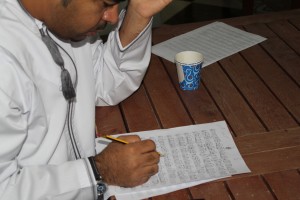
Salim Makrashi corrects a transcription of "Caprice" by Jamil Bashir during the break. One of the students transcriibed the piece and another will reproduce it using the Sibelius music writing program.
I have attended three rehearsals so far and they are disciplined and convivial. Musicians learn both with music and by ear and they perform pieces in unison or composed harmony and counterpoint. Heterophony, the musical texture, that is so characteristic of the ensemble sound from Cairo and the Eastern Mediterranean, is completely absent. As they worked on the piece “Caprice” by Jamil Bashir it became clear that these musicians are very capable. Most of them have developed perfect up and down picking technique, characteristic of Turkish and Iraqi ‘ud performance as well as the ability to play scales and arpeggios way up the neck of then instrument and into the land of harmonics; all of them use a foot rest that elevates the right knee (an adaptation from classical guitar performance practice) and the majority of the players use an Iraqi style ‘ud that has strings that come over a movable bridge and tie on where the face of the ‘ud meets the body. In spite of his incredible talent Salim Makrashi is incredibly patient and good-natured. When someone comes late they are welcomed and those who take longer to “get it” just get more time in the rehearsal to perfect whatever phrase they are working on. Collectivity, and protecting the integrity of the group is the name of the game here.
Which musical aesthetic for Oman?
Fathi Moshin and I looked through piles of music and it is clear that many pieces from the canon of Arabic classical music (forms including the Sama‘i, the Longa, and the pieces of various well known composers and singers, particularly Muhammad ‘Abd al-Wahhab), are practiced and performed here. Nevertheless, this is not the repertoire that the group is rehearsing now or that is on their inaugural CD.
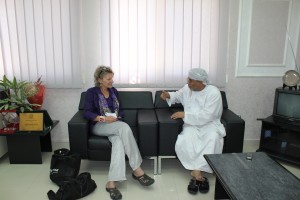
Musallim Kathiri, Composer, Performer, and Director of the Oman Center for Traditional Music at our meeting in December 2010
Musallim Kathiri, Director of the Oman Center for Traditional Music, a fabulous ‘ud player and composer himself, opined that importing Arabic music to Oman (from both Egypt and the Eastern Mediterranean, and from Iraq) has actually impeded or prevented a modern Omani sound and musical theory to emerge. He pointed out that Omani music has no music theory (rules and guidelines about intonation and form, for example) at least none that has been codified and that could be applied to the composition and performance of Oman’s own, urban classical or traditional music. But the musical advocates of the country, including notably his Majesty, Sultan Qaboos, do have the will and the means to import music from other parts of the Arab world and this process of adoption and adaption is what I am experiencing at the ‘Ud Hobbyist Association.
Salim al-Marakshi, who has been directing the group is actually on leave from the Sultan’s firqah and will return to Cairo where he is taking courses in takht conducting at the High institute of Music in Cairo. During our breaks for cigarettes and tea, Salim flips through the music and videos on his iphone, playing for the group a particularly tasty taqasim or the music of Ziyad Rahbani or even of performances of religious songs, known to be the epitome of vocal maqam performance. Through these exercises he performs musical competence and connoisseurship that is more in line with the “old school” musical styles of Egypt or Syria, and literally teaches the musical aesthetics required for both. Advanced students stay late after rehearsal to get a tip or two on their own improvisations. They are hungry for the music. It is a great scene!
[1] www.michiganaraborchestra.com
[2] http://www.adach.ae/en/portal/bait.aloud.aspx

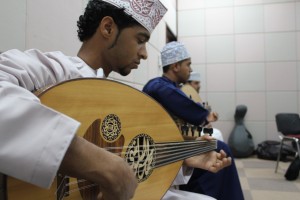
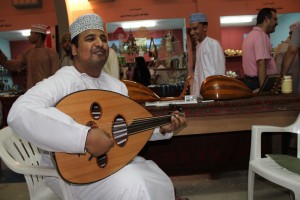
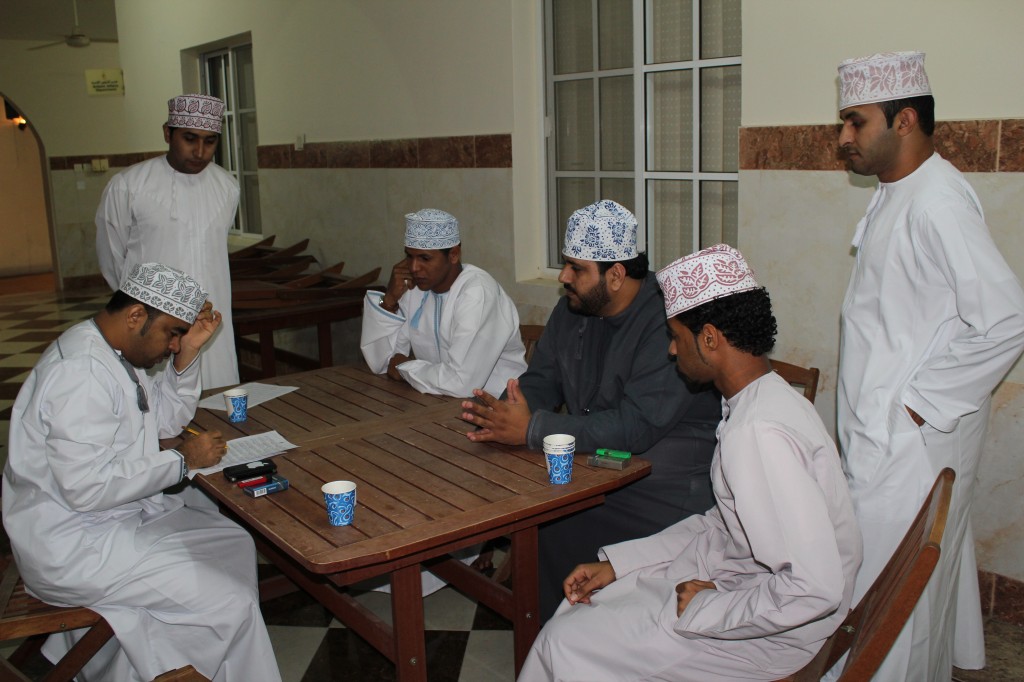

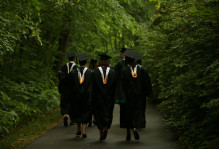
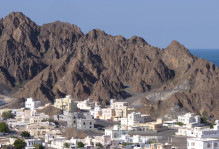
No comments.
Comments are currently closed. Comments are closed on all posts older than one year, and for those in our archive.